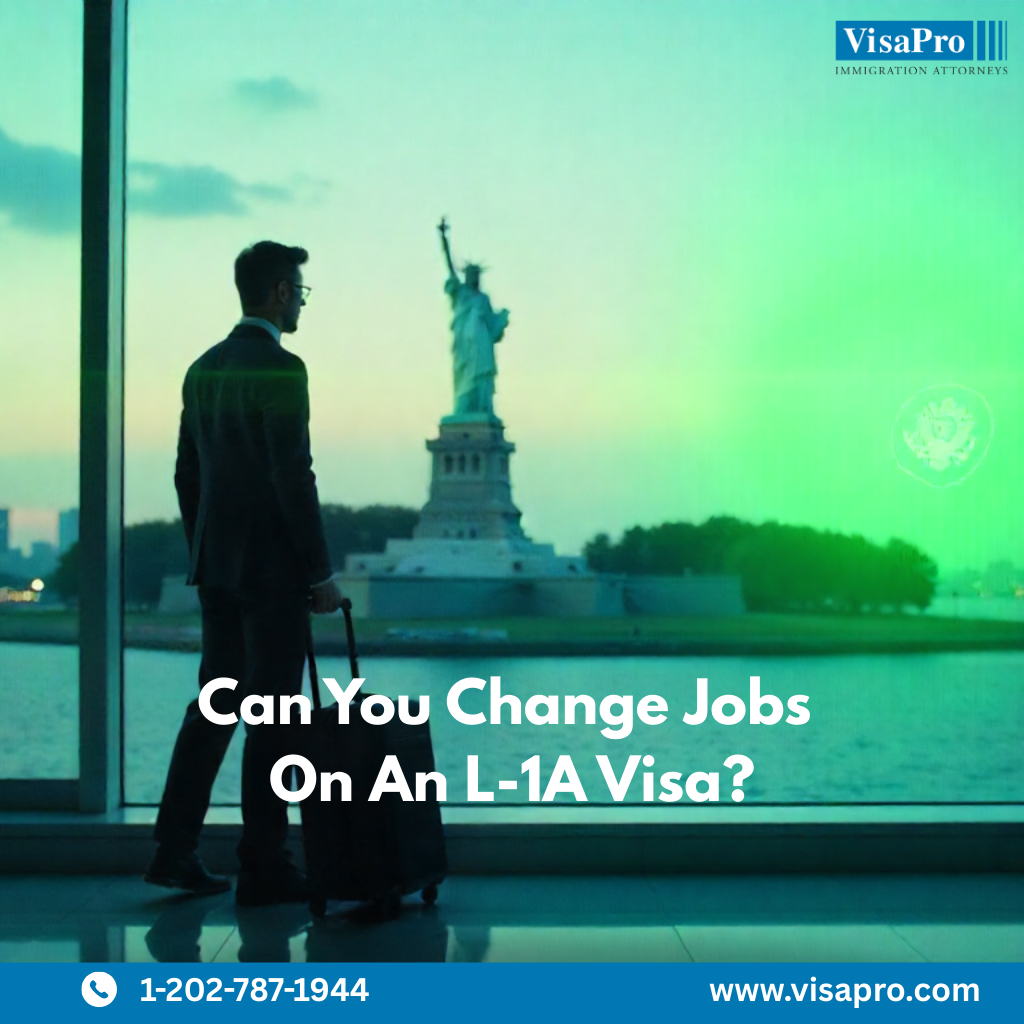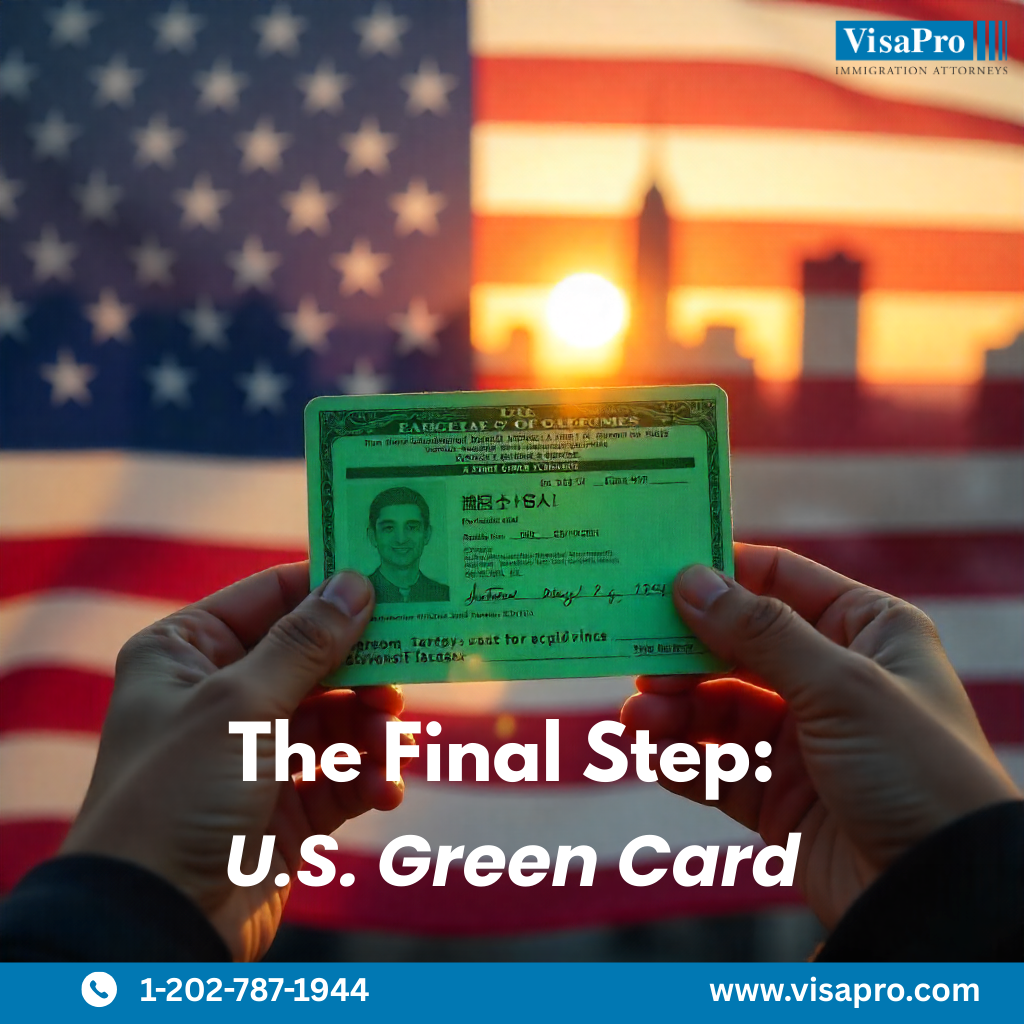Quick Summary:
If you’re on an L-1 visa and wondering, “Can I change jobs or switch companies?” the short answer is no, you cannot freely move to a different U.S. employer. But you do have strong opportunities for permanent residency through your current L-1 employer. In this guide, we’ll break down your options, the green card process, timelines, costs, and what steps you should take to protect your future.
Can You Change Jobs on an L-1 Visa?
No, L-1 visa holders cannot change employers unless it’s a move to another affiliated company within your employer’s multinational network. L-1 status is tied to your sponsoring company and does not allow you to switch to a different, unrelated employer.
The L-1 visa is an intracompany transfer visa, i.e., it allows multinational companies to transfer executives, managers (L-1A), or employees with specialized knowledge (L-1B) from a foreign company to a related U.S. affiliate or branch. This visa is specific to the job and employer listed in your petition.
- If your role changes within the same company, your employer may file an amended L-1 petition to reflect the change.
- If you are being transferred to a different but also related company, your employer will need to file an amended L-1 or change of employer L-1 to reflect the change, dependent on the circumstances.
- But if you want to work for a different company, you cannot simply transfer your L-1. Instead, that new employer must sponsor you for another visa, such as the H-1B, O-1, or even directly for a green card.
- If you resign or are terminated, you immediately fall out of L-1 status and must either depart the U.S. or switch to another valid status.
Common Misunderstanding: Many believe L-1 functions like H-1B where portability is allowed. This is not true.

L-1 To Another Employer: What Are Your Real Options?
You cannot transfer your L-1 visa to another, unrelated company (except in very limited, narrow instances). Generally, to work elsewhere, you must apply for a different visa category like H-1B or wait until you qualify for a green card.
- Option 1: Apply For H-1B Visa – If another company wants to hire you, they must sponsor you for an H-1B. However, the H-1B process involves a Registration process which occurs in March followed by an H-1B Lottery. If picked in the lottery, new filings can only begin in April each year, with employment start dates in October. For example, the earliest new H-1B start date is October 2026.
- Option 2: Explore O-1 Visa – If you have extraordinary ability in your field, an O-1 visa could allow you to join a new employer without waiting for the H-1B cap.
- Option 3: Green Card Sponsorship – Another employer can file a green card for you through PERM labor certification (EB-2 or EB-3). But you cannot start working for them until you secure independent work authorization (like H-1B) or can file Adjustment of Status and secure an Employment Authorization Document
Key Point:
If you’re asking, “Can I change company on an L-1B visa?” or “Can you switch jobs on an L-1A visa?”, the answer is no. You must stay with your L-1 employer or move into a new visa or green card process.

Green Card Options For L-1 Visa Holders
L-1 visa holders are well-positioned for green cards, particularly under the EB-1C category for multinational executives and managers.
The U.S. green card process usually requires three steps:
- PERM Labor Certification (recruitment process)
- Immigrant Petition (Form I-140)
- Adjustment of Status (Form I-485)
But here’s the advantage for EB-1C: L-1A executives and managers may skip the labor certification under the EB-1C category. This means:
- Your employer skips the PERM and can directly file an I-140 immigrant petition as a multinational executive/manager.
- If your priority date is current (and EB-1C is often current for many countries), you can file I-485, Adjustment of Status at the same time.
- This allows you, your spouse, and children under 21 to apply together.
Timeline: EB-1C green card approval can take about 12–18 months.
Alternative Route: If you hold an L-1 visa (specialized knowledge) and don’t qualify for EB-1C, you may need to go through PERM (EB-2/EB-3) unless you qualify for a different category like EB-1A or EB-2 NIW.
Costs And Employer Requirements For EB-1C-Based Green Cards
Most employers are willing to bear the costs for the green card process, though you may cover adjustment of status fees for family members.
Employer Responsibilities:
- File the I-140 petition
- Show that the U.S. branch and the foreign branch (where you worked before transfer in a managerial or executive position) are both still active
- Offer you a permanent executive/managerial role in the U.S.
Typical Costs:
- Employer Costs: Attorney fees + USCIS filing fees for I-140 petition (Payment by the employer is not legally required- so you can volunteer to pay part or all of the fees)
- Employee Costs: I-485 adjustment of status fees (currently $1,440 per applicant) + medical exams + biometrics
Important Tip: Always confirm with your employer that they are willing to pursue EB-1C sponsorship, as the petition must come from them.
What Happens If You Resign or Lose Your Job On L-1?
If you leave your L-1 employer or your employment is terminated, you immediately lose status after an initial grace period. You cannot remain in the U.S. without switching visas or leaving.
- There is a 60-day (or until your I-94 expiration date) discretionary grace period.
- If you resign, you cannot continue stay in the U.S. indefinitely. You must file for a change of status to another visa, like B-2 visitor, or have another employer secure an H-1B or O-1 for you.
- Green card filings by another employer do not give you work authorization unless you have applied for Adjustment of Status and have secured the Employment Authorization Document (EAD).
Example: An L-1A manager resigns to join a startup that promises sponsorship. Unless the startup secures an H-1B or O-1, the employee must leave the U.S. They cannot legally stay and work during a pending PERM/green card process.

L-1 To Green Card: EB-1C Success Example
Many L-1A executives and managers successfully transition to permanent residency through EB-1C.
Case Example:
A German executive worked for her company’s Munich branch for 5 years. She transferred to the U.S. on an L-1A visa as Vice President. After one year, the company filed an EB-1C petition showing her prior executive experience abroad and her U.S. executive role. Within 14 months, her green card was approved, and her spouse and children also received permanent residency. 1 year after obtaining her green card, the executive was offered a lucrative position in another company and she changed employers.
Checklist For EB-1C Eligibility:
- Worked abroad for 1 of the past 3 years before entering U.S.
- U.S. and foreign companies share qualifying corporate relationship
- Offered permanent managerial/executive role in the U.S.
- Employer commits to petitioning on your behalf
Key Takeaways For L-1 Employees Considering Green Cards
L-1 employees cannot switch employers but have a direct and often faster path to a green card through EB-1C.
- You cannot change jobs on an L-1 visa with a new employer.
- If another employer wants to hire you, they must file for a new visa (H-1B, O-1, or EB-2/3 green card).
- EB-1C is the most favorable green card option for L-1A executives/managers, skipping labor certification.
- Resigning or losing your L-1 job immediately jeopardizes your legal status.
VisaPro has successfully guided L-1 executives, managers, and specialized knowledge professionals through both employer changes and green card filings. Let us help you secure your future. Schedule your free strategy call with VisaPro today.
Frequently Asked Questions (FAQ)
1.Can I change company on an L-1 visa?
No. L-1B visas are tied to the sponsoring company. If you want to work for a different company that is unrelated to your foreign employer, you must switch to another visa, like H-1B, or wait until you obtain a green card.
2.Can you change jobs on L-1 visa without leaving the U.S.?
No. There is no portability with L-1. If you want to work for a new employer, they must file a different visa petition. Simply changing jobs is not allowed under the L-1 rules.
3.Can an L-1 visa holder change company while green card is in process?
No. You cannot work for a new employer unless you already have independent work authorization, like H-1B or EAD. A pending green card by itself does not allow employment with another company.
4.Can you switch jobs on L-1A visa to a non-related company?
No. L-1A is strictly limited to qualifying corporate relationships. If you want to switch, the new employer must sponsor you for a different visa type or green card.
5.What happens if my L-1 employer does not want to sponsor a green card?
If your current L-1 employer will not file an EB-1C petition, another employer may sponsor you under EB-1A, EB-2 or EB-3, but you cannot begin working for them until you obtain a valid work visa such as H-1B.
If you’re uncertain about whether you can change employers on your L-1 visa or want to explore the fastest path to a green card, don’t navigate it alone. VisaPro has successfully helped L-1 executives, managers, and professionals secure green cards, avoided status gaps, and protected their families’ futures.
Schedule your free immigration strategy call with VisaPro today and take the next confident step toward your American dream.
What VisaPro Customers Are Saying
The US [B-1] Visa has always been a tough ride, and being denied a few times it makes it even worse. But thanks to VisaPro and their meticulous processing I was granted a Visa. I would like to thank you and all the people involved in making this a success. I would like to recommend VisaPro to all those who seek peace of mind and hassle free Visa processing.”



 Manas Bhat, Director Operations, First Houston Mortgage India
Manas Bhat, Director Operations, First Houston Mortgage India



